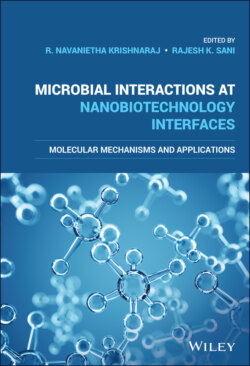Читать книгу Microbial Interactions at Nanobiotechnology Interfaces - Группа авторов - Страница 52
1.10.5 Synthesis Methods and Stabilizing Agents
ОглавлениеThe choice of synthesis methods and stabilizing agents is very crucial in the fabrication of antimicrobial NMs, since these factors also can influence the properties of the NMs to a major extent. As stated, during synthesis, NMs are synthesized by different methods such as laser ablation, mechanical milling, chemical etching, melt mixing, sputtering, and other chemical methods such as thermolysis, microemulsion, and sol–gel. However, the NMs that are synthesized through the chemical or physical methods are unstable, have surface‐attached toxic materials, and are formed along with toxic by‐products. Considering Ag NPs' synthesis, the process involves a reducing agent such as sodium borohydride or sodium citrate with capping agent such as polyethyl glycol. On the other hand, the biological synthesis methods employ biological sources such as microorganisms and plants. In the case of microbial biosynthesis, the microbes exert a bio‐reduction process to reduce and accumulate the metallic ions to avoid the metal‐related toxicity. The mechanism involves the reduction of metal ions inside the cell through intracellular reducing species and outside using their different extracellular metabolites. Plants also contain a number of reducing agents such as proteins, flavonoids, and other water‐soluble biomolecules (Singh et al., 2018). Green synthesis methods improve the stability of NMs with no hazardous by‐products. Further, they provide a biocompatible coating over NMs, which not only improves the biocompatibility but also increases surface area with reactive groups, which can improve the interaction with biological environment (Singh, Garg, Pandit, Mokkapati, & Mijakovic, 2018). For example, Sudhasree et al. (2014) showed that nickel NPs prepared from Desmodium gangeticum were monodispersed. The green synthesized NPs were found to possess high antibacterial activity against Klebsiella pneumonia, Pseudomonas aeruginosa, and Proteus vulgaris whereas the chemically synthesized nickel NPs had the least effect on the same microbes. Apart from enhancing the antimicrobial property, it also improved the biocompatibility as observed from biocompatibility studies using LLC PK1 (epithelial cell lines) (Sudhasree et al., 2014). However, the choice of a particular synthesis method depends on the nature of NM required and the type of applications.
Antimicrobial property is directly proportional to the surface area, surface charge, and the extent of interaction or contact of NMs with bacterial cell. In this regard, understanding the effect of stabilizing agents on NMs is also important. The stabilizing agents reduce agglomeration and provide net charge over NMs. Hence, these stabilizing agents to an extent determine the toxicity or antimicrobial property of the NMs. It was observed from a past study that the Ag NPs stabilized with chitosan and citrate enhanced the antimicrobial property of Ag NPs against multidrug‐resistant bacteria (S. aureus and K. pneumonia). The study also showed that effect of stabilizing agents chitosan and citrate over the microbes was at basal level (Cavassin et al., 2015). Similarly, Ag NPs coated with 11‐mercaptoundecanoic acid exhibited higher toxicity over P. aeruginosa in comparison to Ag NPs coated with citrate. Citrate capping provides net negative charge to the Ag NPs, which results in electrostatic repulsion between negatively charged bacterial cell and Ag NPs. In the case of 11‐mercaptoundecanoic acid capped Ag NPS, the particles agglomerated over the surface of the hydrophilic P. aeruginosa, which facilitated the release of Ag+ ions near the proximity of cell and improved the toxicity of the NPs toward the bacteria (Dorobantu et al., 2015). In another study, El Badawy et al. (2010) studied the toxicity of Ag NPs coated with different capping agents such as citrate, polyvinylpyrrolidone, and branched polyethyleneimine. The coating provided Ag NPs with a range of surface charge from highly negative to highly positive. Among the different coatings, citrate coating showed the least toxicity against Bacillus species. The surface potential of the citrate capped Ag NPs was found to be −38 mV, which was in line with the surface charge of Bacillus species (−37 mV). The electrostatic repulsion between the negatively charged citrate capped Ag NPs and bacteria was the probable reason for the least toxic effect of citrate capped NPs. In accordance with that, highly positively charged branched polyethyleneimine‐coated Ag NPs (+40 mV) showed the highest toxicity whereas uncoated Ag NPs (−22 mV) and polyvinylpyrrolidone‐coated Ag NPs (−10 mV) exerted toxicity above the citrate capped Ag NPs (El Badawy et al., 2010). This clearly reveals that the nature and the structure of stabilizing agents affect the toxicity and the bactericidal potential of the NMs, which should be taken into account while fabricating NMs for antimicrobial properties.
